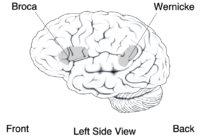Portal:Linguistics
- For a topical guide of this subject, see Outline of linguistics
Welcome to the Linguistics Portal!
Traditional areas of linguistic analysis correspond to context contributes to meaning). Subdisciplines such as biolinguistics (the study of the biological variables and evolution of language) and psycholinguistics (the study of psychological factors in human language) bridge many of these divisions.
Linguistics encompasses many branches and subfields that span both theoretical and practical applications. Theoretical linguistics (including traditional descriptive linguistics) is concerned with understanding the universal and fundamental nature of language and developing a general theoretical framework for describing it. Applied linguistics seeks to utilise the scientific findings of the study of language for practical purposes, such as developing methods of improving language education and literacy. Linguistic features may be studied through a variety of perspectives: synchronically (by describing the shifts in a language at a certain specific point of time) or diachronically (through the historical development of language over several periods of time), in monolinguals or in multilinguals, amongst children or amongst adults, in terms of how it is being learned or how it was acquired, as abstract objects or as cognitive structures, through written texts or through oral elicitation, and finally through mechanical data collection or through practical fieldwork. (Full article... )
Selected article -theoretical linguists , who have produced a number of books, articles, and doctoral theses on the topic.
One of the most important aspects of Irish phonology is that almost all velarized, that is, the back of the tongue is pulled back and slightly up in the direction of the soft palate while the consonant is being articulated. Slender consonants are palatalized, which means the tongue is pushed up toward the hard palate during the articulation. The contrast between broad and slender consonants is crucial in Irish, because the meaning of a word can change if a broad consonant is substituted for a slender consonant or vice versa. For example, the only difference in pronunciation between the words bó ('cow') and beo ('alive') is that bó is pronounced with a broad b sound, while beo is pronounced with a slender b sound. The contrast between broad and slender consonants plays a critical role not only in distinguishing the individual consonants themselves, but also in the pronunciation of the surrounding vowels, in the determination of which consonants can stand next to which other consonants, and in the behavior of words that begin with a vowel. This broad/slender distinction is similar to the hard/soft one of several Slavic languages, like Russian .
The Irish language shares a number of phonological characteristics with its nearest linguistic relatives, Scottish Gaelic and Manx, as well as with Hiberno-English, the language with which it is most closely in contact. Did you know...From Wikipedia's " 
Related PortalsThings you can do
WikiProjectsThe following WikiProjects work to improve topics concerned with linguistics:
Associated WikimediaThe following Wikimedia Foundation sister projects provide more on this subject:
Discover Wikipedia using portals |



























